

|
| ÖSTERREICH | AUSTRIA |
| Bundesland: Steiermark | Styria |
| Bezirk: Südoststeiermark |
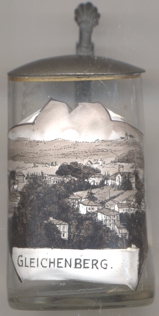 The first mentioning of Gleichenberg (glichenberch) is found in a document of 1185.
Archeological finds prove that the mineral springs had already been used by the Romans.
At the end of the 18th century the mineral content of the waters was rediscovered.
The resort was founded by Mathias Constantin Capello Count Wickenburg in 1834.
The first mentioning of Gleichenberg (glichenberch) is found in a document of 1185.
Archeological finds prove that the mineral springs had already been used by the Romans.
At the end of the 18th century the mineral content of the waters was rediscovered.
The resort was founded by Mathias Constantin Capello Count Wickenburg in 1834.
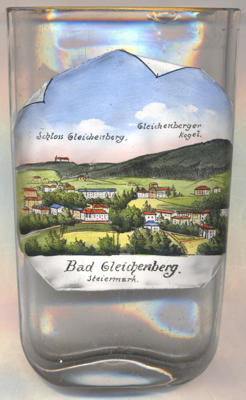
The mountain  Gleichenberger Kogel
[near left, no. 3116: background right] (598 m) and its second summit,
Bschaidkogel (563 m), are the remains of two extinct volcanos that had been active about 12 to 17
millions years ago when they were located in the Parathetys ocean. Their very similar shape
is the origin of the name of Bad Gleichenberg (gleich = equal; Berg = mountain).
Gleichenberger Kogel
[near left, no. 3116: background right] (598 m) and its second summit,
Bschaidkogel (563 m), are the remains of two extinct volcanos that had been active about 12 to 17
millions years ago when they were located in the Parathetys ocean. Their very similar shape
is the origin of the name of Bad Gleichenberg (gleich = equal; Berg = mountain).
The castle  Schloss (Neu-)Gleichenberg
[top left] was erected at the beginning of the 14th century after the destruction of
the old castle (Alt-Gleichenberg) by King Ottokar II in 1268.
In 1945, the castle was destroyed. The final destruction of the remaining ruins happened in 1983 by a fire.
Schloss (Neu-)Gleichenberg
[top left] was erected at the beginning of the 14th century after the destruction of
the old castle (Alt-Gleichenberg) by King Ottokar II in 1268.
In 1945, the castle was destroyed. The final destruction of the remaining ruins happened in 1983 by a fire.
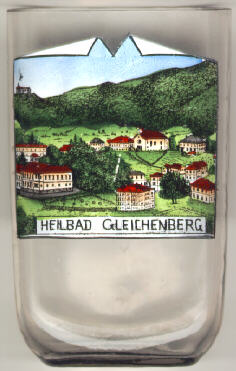
Further buildings depicted on glass no. 104 [near left]:
 Villa Wickenburg [bottom left]
(1836/37, enlarged 1859, 1899, destroyed 1945, reconstructed 1955).
Villa Wickenburg [bottom left]
(1836/37, enlarged 1859, 1899, destroyed 1945, reconstructed 1955).
 Parish church St. Mathias
Parish church St. Mathias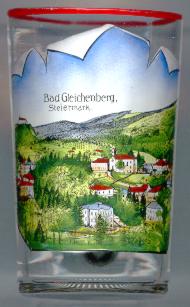
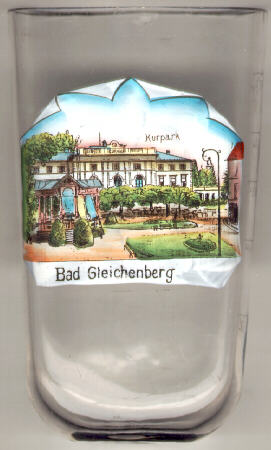
The mineral water was already sold in bottles since 1819. During the 19th century
Gleichenberg became one of the most fashionable health resorts of Central Europe.
The predicate ‘Bad’ was awarded in 1926. Following the severe destructions of 1945
the resort was modernized frequently. Thermal mineral springs were found 1973 and 1979.
The  Kurhaus [left, no. 335],
built in 1870 and enlarged in 1919–1930, was the centre of the heart of the spa. It also contained a museum
exhibiting the archeological finds from the prehistorical, Celtic and Roman times. The building
was completely destroyed in 1945 and everything from the museum was lost. The ruins were removed
in 1951, only the foundation walls were left as a memorial.
Kurhaus [left, no. 335],
built in 1870 and enlarged in 1919–1930, was the centre of the heart of the spa. It also contained a museum
exhibiting the archeological finds from the prehistorical, Celtic and Roman times. The building
was completely destroyed in 1945 and everything from the museum was lost. The ruins were removed
in 1951, only the foundation walls were left as a memorial.
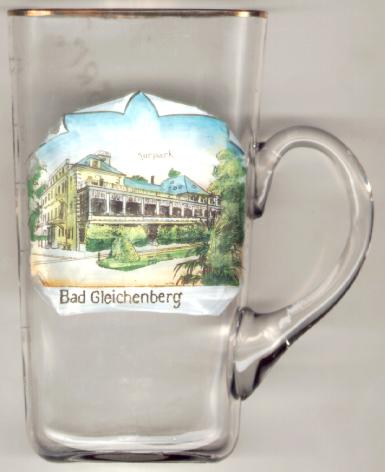
The  Kurhotel [near left, no. 464]
was created 1927-29 by enlargement of the former Vereinsrestaurant [see below, no. 464].
During World War II it was used
as military hospital. 1982-1994 it was a vocational school of the province of Styria.
Kurhotel [near left, no. 464]
was created 1927-29 by enlargement of the former Vereinsrestaurant [see below, no. 464].
During World War II it was used
as military hospital. 1982-1994 it was a vocational school of the province of Styria.
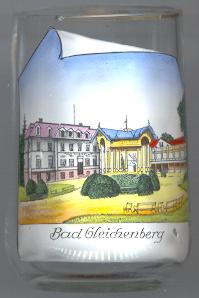
The  Vereinsrestaurant [near left, no. 554: background right]
was built in 1900. In 1927–1929 it was rebuilt and reopened
as Kurhotel [see no. 464 above].
Vereinsrestaurant [near left, no. 554: background right]
was built in 1900. In 1927–1929 it was rebuilt and reopened
as Kurhotel [see no. 464 above].
 Villa Albrecht
[near left, no. 554: left] was built in 1869 as Villa Höflinger and remodelled before 1903.
Villa Albrecht
[near left, no. 554: left] was built in 1869 as Villa Höflinger and remodelled before 1903.
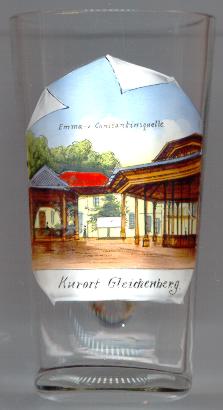
The mineral springs Emmaquelle and Constantinquelle
[left, no. 814]
were named after Mathias Constantin Capello Count Wickenburg and his wife, Emma.
Emmaquelle and Constantinquelle
[left, no. 814]
were named after Mathias Constantin Capello Count Wickenburg and his wife, Emma.
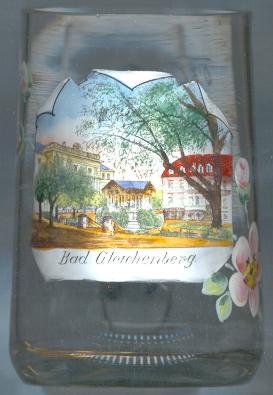
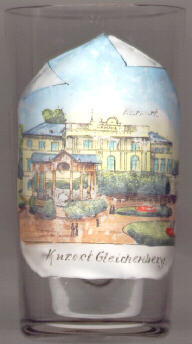
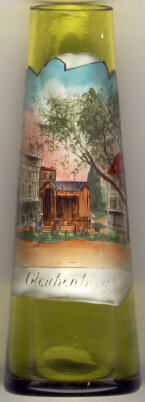
![[scale]](lineal.jpg)